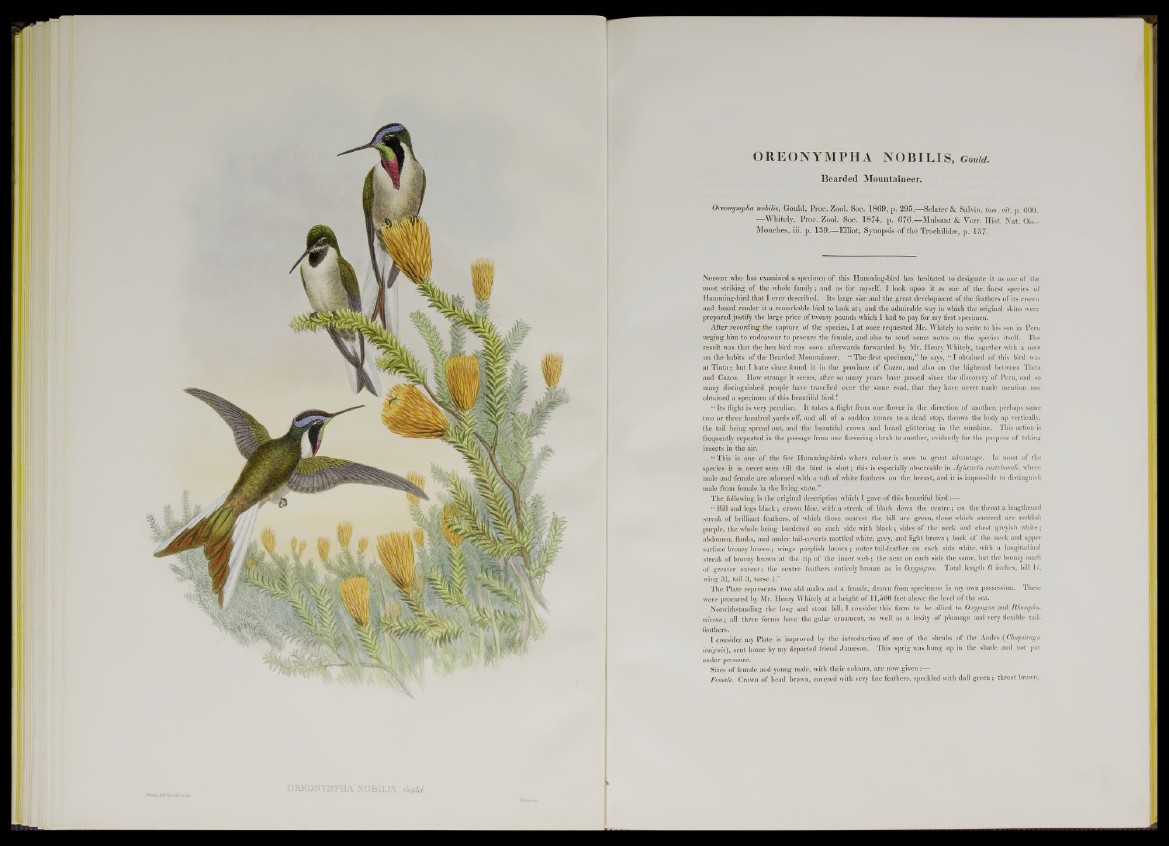
OREQNYMPBA NQBDLIS, Gould/.
OREONYMPHA NOBILIS, Gould.
Bearded Mountaineer.
Oreonynvpha nobilis, Gould, Proc. Zool. Soc. 1 8 6 9 , p. 2 9 5 .— Sclater & Salvin, tom. cit. p. 6 00.
— W h ite ly , Proc. Zool. Soc. 1 8 7 4 , p. 6 7 6 .— Mulsant & Verr. Hist. N a t. Ois.-
Mouches, iii. p. 1 3 9 .— Ellio t, Synopsis o f the Trochilidse, p. 157.
N obody who has examined a specimen of this Humming-bird has hesitated to designate it as one o f the
most striking o f the whole family; and as for myself, I look upon it as one of the finest species of
Humming-bird that I ever described. Its large size and the great development of the feathers o f its crown
and beard render it a remarkable bird to look a t; and the admirable way in which the original skins were
prepared justify the large price o f twenty pounds which I had to pay for my first specimen.
After recording the capture o f the species, I at once requested Mr. Whitely to write to his son in Peru
urging him to endeavour to procure the female, and also to send some notes on the species itself. The
result was that the hen bird was soon afterwards forwarded by Mr. Henry Whitely, together with a note
on the habits o f the Bearded Mountaineer. “ The first specimen,” he says, “ I obtained o f this bird was
at Tinta; but I have since found it in the province o f Cuzco, and also on the highroad between Tinta
and Cuzco. How strange it seems, after so many years have passed since the discovery of Peru, and so
many distinguished people have travelled over the same road, that they have never made mention nor
obtained a specimen o f this beautiful bird !
“ Its flight is very peculiar. It takes a flight from one flower in the direction of another, perhaps some
two or three hundred yards off, and all of a sudden comes to a dead stop, throws the body up vertically,
the tail being spread out, and the beautiful crown and beard glittering in the sunshine. This action is
frequently repeated in the passage from one flowering shrub to another, evidently for the purpose of taking
insects in the air.
“ This is one o f the few Humming-birds where colour is seen to great advantage. In most o f the
species it is never seen till the bird is sho t; this is especially observable in Aglceactis castelnaudi, where
male and female are adorned with a tuft of white feathers on the breast, and it is impossible to distinguish
male from female in the living state.”
The following is the original description which I gave of this beautiful bird:—
“ Bill and legs black ; crown blue, with a streak of black down the centre; on the throat a lengthened
streak o f brilliaut feathers, o f which those nearest the bill are green, those which succeed are reddish
purple, the whole being bordered on each side with black; sides of the neck and chest greyisli white;
abdomen, flanks, and under tail-coverts mottled white, grey, and light brown; back o f the neck and upper
surface bronzy brown; wings purplish brown; outer tail-feather on each side white, with a longitudinal
streak o f bronzy brown at the tip o f the inner web; the next on each side the same, but the bronzy mark
o f greater extent; the centre feathers entirely bronze as in Oxypogon. Total length 6 inches, bill 1»,
wing ¡¡pi tail 3, tarse I"
The Plate represents two old males and a female, drawn from specimens in my own possession. These
were procured by Mr. Henry Whitely at a height o f 11,500 feet above the level o f the sea.
Notwithstanding the long and stout bill, I consider this form to be allied to Oxypogon and Rhampho-
micron; all three forms have the gular ornament, as well as a laxity of plumage and very flexible tail-
feathers.
I consider my Plate is improved by the introduction o f one of the shrubs o f the Andes ( CAuquiraga
insignis) , sent home by my departed friend Jameson. This sprig was hung up in the shade and not put
under pressure.
Sizes o f female and young male, with their colours, are now given :4 | £ |
Female. Crown o f head brown, covered with very fine feathers, speckled with dull green; throat brown,